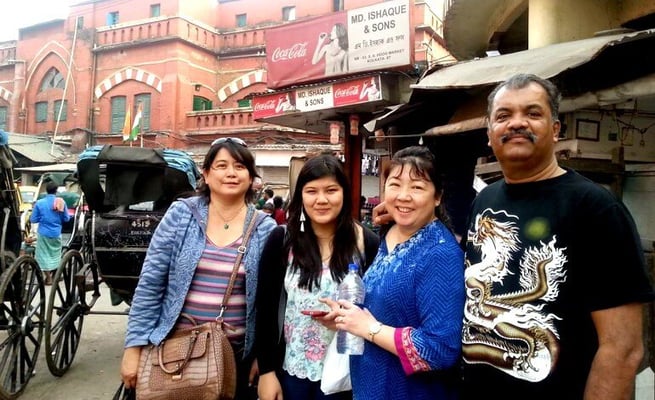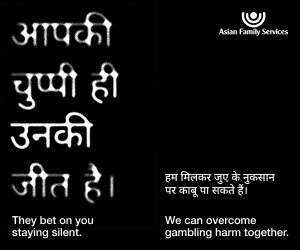Living in NZ: A Chinese-descent Indian shares her unique cultural experience

Amidst the often tense, and mutually-competitive geopolitical rivalry, between the two Asian giants - India and China – not many people would expect that there has been a small, invisible community of the India-born Chinese people living quietly in India, for at least hundreds of years.
And expecting members of such a community – a living example of how the processes of migration influence their life-experiences of engaging with multiple cultures – to be living quietly in New Zealand for the last two decades, was in itself eventful.
Yamshya Lee-sands, 50, an India-born Chinese descent mum, has been living in Auckland with her Kiwi husband and two boys since 2001 when she first emigrated from India.

She is a living epitome of reflecting multiple identities - and a mixture of Chinese and Indian heritage that not many people, even in India, would be much cognizant about.
“Cherishing multiple cultural identities,” was her apt reply to the Indian Weekender’s query of what she thinks of her mixed Chinese-Indian heritage.
Born in Calcutta and lived in different parts of India, particularly Andhra Pradesh and Bangalore, Yamshya, belongs to the Hakka Chinese people whose ancestral homes are chiefly in the Hakka-speaking provincial areas of Guangzhou, on the north shore of South China Sea, from where they have migrated to different parts of the world.

Entrepreneurial by nature Hakka Han Chinese people have migrated all around the world, and reached the shores of India during the British rule with the first person of Chinese origin recorded to have arrived in Calcutta in 1798. Since then Chinese Hakka people have been regularly coming in search of greener pastures and settled in ethnic neighbourhoods of prominent port cities of Calcutta, Mumbai and Chennai.
It is these earliest communities who have seen the emergence of famous Chinatowns in different parts of India.
The Calcutta’s Chinatown was an iconic neighbourhood near Lalbazar in central Kolkata, where most of the Hakka Chinese people had moved, with the locality once booming with 20,000 ethnic Chinese Indian nationals.

The traditional occupation of the Chinese Indian community in Kolkata had been working in the nearby tanning industry along with being sauce manufacturers, shoe shop owners, restaurateurs and beauty parlours owners.
The restaurants have given rise to fusions of Chinese (especially Hakka) and Indian culinary traditions in the widely available form of Indian Chinese cuisine.
Similarly, the shoe shops lining Bentick Street, near Dharmatolla, which is a must-visit place in the itinerary of every tourist, are owned and operated by Chinese-descent Indian people.

And all of these glimpses of unique history and identity of the Chinese descent Indian community was vivid in Yamshya’s memory revisit during the interview with the Indian Weekender.
“We heard from our father that his uncle had brought their grandfather to Gateway of India port in Calcutta in search of better prospects.”
“They choose Calcutta because they wanted access by land, sea and water.”

“My earliest forefathers were allowed in India without the need for any visa or paperwork during those days.”
“My father and the next generation were allowed to have either British or Chinese or the Indian passport. Although getting an Indian passport was very tough. So in the earliest days, we became stateless,” Mrs Yamshya recalls her family’s earliest tryst in India.
“Our families made hand-made shoes in Bentinck Street – a street which is full of Chinese descent Indian people,” Yamshya fondly recalls.

Migration often leaves a trail of complex human emotions, uprooting people from one’s original culture and taking them to distant alien lands in pursuit of different life-goals, and thereby enunciating an endless internal conversation about their cultural identity.
Yamshya had similar internal, intellectual convulsions, which has progressively settled over a period of time as she carried on with her life.
“When I lived in South India as a kid I recall being fondly called as Chinna – Chinna.”

“Initially, as a child, it took some time for me to process this, however, subsequently I realised that we were well embraced in the Indian society and we were made to feel special.”
“At home, we speak Hakka language, cook, and eat Hakka food. However, gradually we blended with Indian food and culture,” Yamshya said.
She speaks here native Hakka Chinese language, fluent Hindi, and a little bit Telugu language along with English.

Revealing further about her Kiwi-Pakeha husband and two sons, who are often amused to learn about their mix Kiwi-Indian and Chinese ancestry, Yamshya said, “My children are fully aware and mindful of our mixed ancestry, and I try to educate them about the good things of both the worlds.”
Yamshya had arrived in New Zealand in 2001 and worked multiple jobs before marrying her Kiwi-husband and jointly owning and managing a new business.
She often travels to India to meet her close families and cousin sisters who have married in India to people of different regional cultures, while plans to visit China to their original home is still on the cards and that she hopes to accomplish soon.

Although, one of her sons is soon travelling to China as part of the interschool exchange program – something that she is looking forward to with much excitement.
Yamshya is completely at ease with her multiple cultural identities and considers it as a blessing of a repeated number of long-distance migration over a short period of time.
Amidst the often tense, and mutually-competitive geopolitical rivalry, between the two Asian giants - India and China – not many people would expect that there has been a small, invisible community of the India-born Chinese people living quietly in India, for at least hundreds of years.
And...
Amidst the often tense, and mutually-competitive geopolitical rivalry, between the two Asian giants - India and China – not many people would expect that there has been a small, invisible community of the India-born Chinese people living quietly in India, for at least hundreds of years.
And expecting members of such a community – a living example of how the processes of migration influence their life-experiences of engaging with multiple cultures – to be living quietly in New Zealand for the last two decades, was in itself eventful.
Yamshya Lee-sands, 50, an India-born Chinese descent mum, has been living in Auckland with her Kiwi husband and two boys since 2001 when she first emigrated from India.

She is a living epitome of reflecting multiple identities - and a mixture of Chinese and Indian heritage that not many people, even in India, would be much cognizant about.
“Cherishing multiple cultural identities,” was her apt reply to the Indian Weekender’s query of what she thinks of her mixed Chinese-Indian heritage.
Born in Calcutta and lived in different parts of India, particularly Andhra Pradesh and Bangalore, Yamshya, belongs to the Hakka Chinese people whose ancestral homes are chiefly in the Hakka-speaking provincial areas of Guangzhou, on the north shore of South China Sea, from where they have migrated to different parts of the world.

Entrepreneurial by nature Hakka Han Chinese people have migrated all around the world, and reached the shores of India during the British rule with the first person of Chinese origin recorded to have arrived in Calcutta in 1798. Since then Chinese Hakka people have been regularly coming in search of greener pastures and settled in ethnic neighbourhoods of prominent port cities of Calcutta, Mumbai and Chennai.
It is these earliest communities who have seen the emergence of famous Chinatowns in different parts of India.
The Calcutta’s Chinatown was an iconic neighbourhood near Lalbazar in central Kolkata, where most of the Hakka Chinese people had moved, with the locality once booming with 20,000 ethnic Chinese Indian nationals.

The traditional occupation of the Chinese Indian community in Kolkata had been working in the nearby tanning industry along with being sauce manufacturers, shoe shop owners, restaurateurs and beauty parlours owners.
The restaurants have given rise to fusions of Chinese (especially Hakka) and Indian culinary traditions in the widely available form of Indian Chinese cuisine.
Similarly, the shoe shops lining Bentick Street, near Dharmatolla, which is a must-visit place in the itinerary of every tourist, are owned and operated by Chinese-descent Indian people.

And all of these glimpses of unique history and identity of the Chinese descent Indian community was vivid in Yamshya’s memory revisit during the interview with the Indian Weekender.
“We heard from our father that his uncle had brought their grandfather to Gateway of India port in Calcutta in search of better prospects.”
“They choose Calcutta because they wanted access by land, sea and water.”

“My earliest forefathers were allowed in India without the need for any visa or paperwork during those days.”
“My father and the next generation were allowed to have either British or Chinese or the Indian passport. Although getting an Indian passport was very tough. So in the earliest days, we became stateless,” Mrs Yamshya recalls her family’s earliest tryst in India.
“Our families made hand-made shoes in Bentinck Street – a street which is full of Chinese descent Indian people,” Yamshya fondly recalls.

Migration often leaves a trail of complex human emotions, uprooting people from one’s original culture and taking them to distant alien lands in pursuit of different life-goals, and thereby enunciating an endless internal conversation about their cultural identity.
Yamshya had similar internal, intellectual convulsions, which has progressively settled over a period of time as she carried on with her life.
“When I lived in South India as a kid I recall being fondly called as Chinna – Chinna.”

“Initially, as a child, it took some time for me to process this, however, subsequently I realised that we were well embraced in the Indian society and we were made to feel special.”
“At home, we speak Hakka language, cook, and eat Hakka food. However, gradually we blended with Indian food and culture,” Yamshya said.
She speaks here native Hakka Chinese language, fluent Hindi, and a little bit Telugu language along with English.

Revealing further about her Kiwi-Pakeha husband and two sons, who are often amused to learn about their mix Kiwi-Indian and Chinese ancestry, Yamshya said, “My children are fully aware and mindful of our mixed ancestry, and I try to educate them about the good things of both the worlds.”
Yamshya had arrived in New Zealand in 2001 and worked multiple jobs before marrying her Kiwi-husband and jointly owning and managing a new business.
She often travels to India to meet her close families and cousin sisters who have married in India to people of different regional cultures, while plans to visit China to their original home is still on the cards and that she hopes to accomplish soon.

Although, one of her sons is soon travelling to China as part of the interschool exchange program – something that she is looking forward to with much excitement.
Yamshya is completely at ease with her multiple cultural identities and considers it as a blessing of a repeated number of long-distance migration over a short period of time.









Leave a Comment